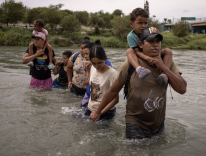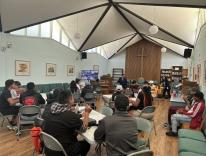The terrorist attacks of September 11 present a fundamental challenge for faith-based immigrant advocates and service providers. As Catholics we identify migrants as our brothers and sisters, see in them the face of God, and recognize a duty to welcome them. In the United States, the church defends immigrants, in part, through a remarkable network of 240 charitable legal-service offices. The church does not support open borders or a straight civil-liberties approach to immigration policy. A sovereign state has the right to control its borders and to manage immigration in furtherance of the "common good." Yet, the common good is not served by the denial of human rights to immigrants. Nations exist precisely to safeguard and promote these rights. The question, then, is how to address the legitimate security threat posed by a small number of foreign-born terrorists, while working to welcome our nation’s more than 30 million foreign-born inhabitants. A recent report on the U.S.-Mexico border by the Catholic Legal Immigration Network, Inc. (CLINIC) highlights the difficulty of striking the right balance between national security and individual rights. The report documents in stark human terms the problems of a region that is both the nation’s poorest and the most affected by U.S. immigration policies. Policymakers would do well to heed the report’s lessons as they consider further changes to immigration laws and policies after September 11. CLINIC’s report does not argue against secure borders, but it demonstrates the costs and limitations of strict enforcement policies. Over the last seven years, the United States has established blockades at traditionally heavy crossing points. This strategy has been supported by a more than fourfold increase in Border Patrol funding since 1990. The Border Patrol employs roughly 10,000 agents-a full 60 percent of all federal law enforcement officers-with 93 percent of them stationed on the Southwest border. Overall, illegal entries increased in the years after the blockade policy went into effect. The mixed success of this strategy (on its own terms) should come as no surprise. The U.S.-Mexico border extends 2,000 miles over forbidding terrain that offers endless hiding places and crossing routes. Individual Border Patrol sectors cover tens of thousands of square miles. Before September 11, the Immigration and Naturalization Service (INS) estimated that it would need an additional 3,200 to 5,500 agents to implement its blockade strategy. The administration’s 2003 budget calls for a doubling of the Border Patrol, with a particular focus on the U.S.-Canada border. Since September 11, undocumented migrant flows have dwindled. Some migrants have decided to forgo visits home and remain in the United States. Others have left or failed to come because of the U.S. economic slowdown and the fear of terrorism. This indicates that migration flows depend not exclusively or even primarily on enforcement policies, but on larger socio-economic factors. For this reason, the U.S.-Mexico dialogue on economic development and regularization (legalization) of migrant flows must continue. Although the border-blockade strategy has not decreased illegal entries, it has redirected migrants to more dangerous crossing routes and led to an increase in migrant deaths from dehydration and hypothermia. Since 1998, more than fifteen hundred people have died trying to cross the U.S.-Mexico border, typically in attempts to work or to join their families in the United States. CLINIC’s report provides wrenching accounts of several migrant deaths. It also offers the perspectives of Mexican officials, Border Patrol agents, and border residents who regularly find migrants dead or near death. Increased border enforcement could put migrants at even more peril. Beyond migrant-crossing deaths, Border Patrol agents have inundated many communities. INS funding for enforcement and border affairs now exceeds the "general funds" of all Southwest border counties combined. It would be difficult to conceive how a city like Douglas, Arizona, with a population of 14,000, could accommodate more than the 560 agents already stationed in the area. Despite the real professionalism of most agents, CLINIC’s account of a raid on an El Paso homeless shelter should give pause to those who would create an even larger federal police force in border communities. CLINIC also describes the tragedy of an infant who perished at a port-of-entry while agents demanded that his father produce the child’s U.S. birth certificate. High Border Patrol attrition rates and the rapid hiring of agents, which seem inevitable following September 11, make the risk of civil-rights abuses even greater. In recent months, policymakers have focused on the need to improve intelligence on legal immigrants and assure their identity because many of the September 11 terrorists entered legally with temporary visas. The government must also confront the risk of a bomb or chemical agent entering the United States in one of the more than 16 million trucks or 5 million 40-ft. sea and railroad containers that enter the country annually. The issues of identity and intelligence-knowing who enter, why, what they do here, and when they leave-also argue for the integration of law-abiding undocumented immigrants into our nation’s life. A broad legalization program, available to immigrant laborers, would be the best way to accomplish this. It would also reduce border-crossing deaths (by allowing for legal crossings), strengthen the position of low-wage laborers, and safeguard immigrant families whose very integrity, as CLINIC’s report shows, has been undermined by the harsh immigration laws passed in 1996. The legalization of hard-working migrants, now compelled to cross the border illegally at their peril, would also allow the United States to concentrate its border enforcement resources on drug traffickers and potential terrorists. This might well obviate the need for further Border Patrol increases. While desirable in its own right, legalization should be accompanied by stronger worker-protection laws and better enforcement of the laws that already exist. Jobs with subsistence-level wages, no benefits, and hazardous conditions characterize immigrant-dominated industries, particularly in border communities. CLINIC’s report features the case of a seventy-one-year-old agricultural laborer who sees his current situation as far more difficult than when he worked in the notorious "bracero" program forty years ago. Given the paltry resources devoted to the enforcement of U.S. labor laws and the exclusion of agricultural laborers from the National Labor Relations Act, nobody should be surprised by this man’s plight. The report also argues for a renewed commitment to the protection of refugees. Advocates have long opposed a provision of the law for the expedited barring of migrants (at the border) who lack adequate documents, unless they request asylum or express a fear of persecution. This system creates an ongoing risk that bona fide asylum seekers will be returned to their persecutors. The report highlights U.S.-funded migrant interception programs in Mexico and Central America that raise similar concerns. One INS enforcement initiative last year intercepted thirty-five hundred migrants, who (according to a delegation of U.S. bishops) were denied the opportunity to apply for asylum. According to CLINIC’s report, U.S. officials at the border occasionally force migrants at U.S. ports of entry to seek asylum outside the United States. Most recently, local INS officials have said that, based on document fraud, they would begin to refer for criminal prosecution more persons not granted asylum. This will certainly chill and undermine the right to seek asylum. In becoming a more secure country, the United States should not lose its identity as a haven for the oppressed or undermine the international regime of refugee protection. The Catholic Church stands in solidarity with the victims of terrorist attacks in the United States, and with migrants fleeing poverty, natural disaster, and terror in their countries of birth. National security is important, but so is the integration of law-abiding immigrants into our nation’s life. Preventing terrorists from entering the country is no excuse for the current number of migrant-crossing deaths. The rights of immigrant families, low-wage laborers, and asylum seekers must be protected. Although this represents a difficult challenge, our immigration policies must accommodate both security concerns and this nation’s traditional openness to those seeking refuge from oppression, whether political or economic.
Please email comments to [email protected] and join the conversation on our Facebook page.
Share
Previous Story
The do-nothings
Next Story
Toward a 'Catholic' Theater

